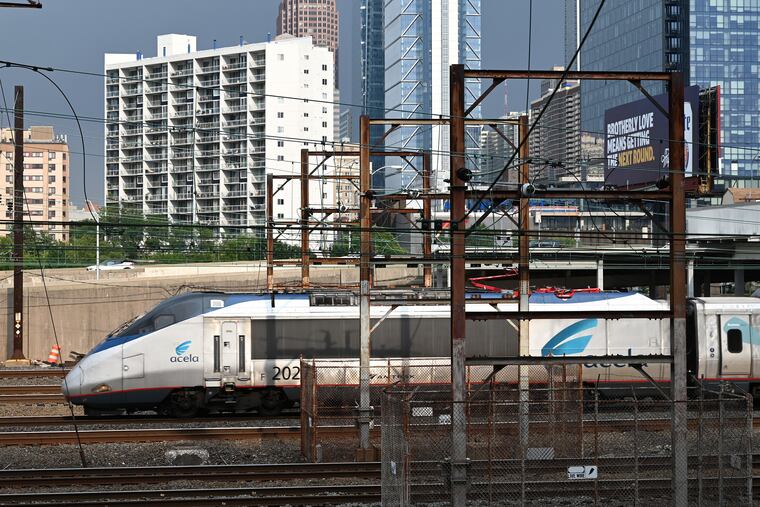A new East Coast Maglev train project would butcher natural lands | Opinion
High-efficiency transit doesn't need to destroy acres of forest and wetlands.

Like everyone else born and raised in the Philadelphia area, I know what it’s like to be stuck on I-95, amid the blaring horns and fender benders, thinking, “There has got to be a better way to get home.”
As our country looks to make bold investments both in infrastructure and climate change resilience — and our region reels from Hurricane Ida, which unleashed flooding that closed the Vine Street Expressway and part of the Schuylkill Expressway — it’s only natural that high-speed rail gets fast-tracked to the top of our minds, especially in East Coast cities clogged by traffic like Philly or Washington, D.C.
Polling from Smart Growth America shows that 77% of voters believe the U.S. overall would benefit from expanding public transit. High-speed rail could be part of America’s transit future.
But the proposed Baltimore-Washington Superconducting Maglev high-speed rail project, described in a recent Inquirer op-ed, is a one-way ticket in the wrong direction. The current proposal should not be approved, much less expanded. Instead, we should make bold investments in existing rail options like Amtrak. Here’s why.
» READ MORE: It’s time for the Northeast Corridor to lead the ‘second great railroad revolution’ | Opinion
The Baltimore-Washington Maglev project would permanently impact more than 300 acres of federal public land, per the January environmental impact study of the project. This includes the Baltimore-Washington Parkway, which is part of the National Parks System, and the Patuxent Research Reserve, a wildlife refuge owned by the U.S. Fish and Wildlife Service. That’s not counting the more than 450 acres of forestland that would be bulldozed, or the more than 50 acres of wetlands that would be filled in.
The destruction of these forests and wetlands conflicts with President Joe Biden’s 30x30 initiative, which aims to protect at least 30% of American lands and waters by 2030. This historic plan is necessary in order to fight climate change and biodiversity loss and ensure the continued availability of clean air and water. We need to protect more land, not less.
We do not have to settle for a flawed mass transit project that bulldozes through public lands, or no mass transit project at all. If our elected officials want to invest billions of dollars into mass transit, why not start with Amtrak? Our current transit systems lag behind those in other countries. An influx of cash would exponentially increase Amtrak’s capacity and reliability. Local transit routes in places like Philadelphia, Maryland, and Washington, D.C., could use a boost of federal funding.
The Baltimore-Washington section of Maglev could cost nearly $13 billion to construct, and the average cost of a one-way ticket would be $60, eight times more than the same trip on the local commuter rail line. Despite the Northeast Maglev’s public claims that the project would require no public funding, project proponents requested $300 million from Congress in May and successfully fought against a bill in the Maryland General Assembly that would have blocked state transit dollars from funding the project. There are only so many transit dollars to go around. This project would divert much-needed public funds from existing, more affordable systems like Amtrak.
Not only would making bold investments in Amtrak and other existing local rail projects be better for the environment, it would be more just and equitable for communities up and down the East Coast.
» READ MORE: High-speed rail plans should appeal even to staunch critics | Opinion
As is often the case in these kinds of proposals, emissions and other harm from Maglev would disproportionately impact communities of color. People of color make up nearly 70% of the total population in the project study area, and low-income people make up more than 12% of the impacted population. These communities will bear the brunt of significant increases in air pollution, light pollution, and property loss that would come from the multiyear construction and long-term operation of the train.
To add insult to injury, many of the neighborhoods most impacted by Maglev construction and operation likely will not benefit from this new train line running through their backyards. The expensive tickets will price out many community residents. No stations are proposed between Baltimore and Washington to allow local ridership.
Proponents attempt to sell this project as the high-tech, shiny solution to many problems caused by fossil fuel-burning cars. But the draft environmental impact statement prepared by the Federal Railroad Administration confirms that building and operating Maglev would increase net carbon dioxide emissions from 286 million to 336 million kilograms per year compared with existing infrastructure. Operating the Maglev would require enough additional energy to power an estimated 88,900 homes annually.
We have already lost too much irreplaceable green space in my hometown of Philadelphia and up and down the East Coast. I urge elected officials in Washington and in every town on the proposed Maglev path to reconsider their support for this project. It will hurt our communities and set a bad precedent for inappropriate, damaging development on America’s public lands.
Theresa Pierno is president and CEO of the National Parks Conservation Association.